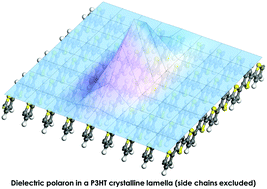Polaron formation mechanisms in conjugated polymers
Abstract
In semiconducting polymers, interactions with conformational degrees of freedom can localize charge carriers, and strongly affect charge transport. Polarons can form when charges induce deformations of the surrounding medium, including local vibrational modes or dielectric polarization. These deformations then interact attractively with the charge, tending to localize it. First we investigate vibrational polaron formation in poly(3-hexylthiophene) [P3HT], with a tight-binding model for charges hopping between adjacent rings, coupled to ring distortions. We use density functional theory (DFT) calculations to determine coupling constants, including the “spring constant” for ring distortions and the coupling to the charge carrier. On single chains, we find only broad, weakly bound polarons by this mechanism. In 2d crystalline layers of P3HT, even weak transverse hopping between chains destabilizes this polaron. Then, we consider polarons stabilized by dielectric polarization, described semiclassically with a polarizable continuum interacting with the carrier wavefunction. In contrast to vibrational polarons, we find dielectrically stabilized polarons in P3HT are narrower, more strongly bound, and stable in 2d crystalline layers.



 Please wait while we load your content...
Please wait while we load your content...